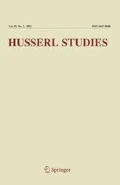Notes
All translations from Hua XXXIX are my own.
If the living world-horizon exists in advance, Husserl meets the objection that we do not have access to the world by disclosing objects over and over again because the world is given as a container before objects are constituted as worldly contents. According to E. Fink’s critical remark, horizons are not indexes for more, but rather dimensions for further determination (see Fink 2006, pp. 261, 300, 417).
On the two senses of pregivenness, see E. Fink’s account in Hua Dok II/2, pp. 93–100.
See Hua III/2, pp. 590 f.; Hua XV, p. 193; Hua XXIX, p. 296; Hua XXXII, p. 15. D. Welton levels a criticism at Husserl’s statement that the world is “the universal object of a universal experience” (Hua IX, p. 95). He argues that the world is turned into an object and concealed as a transcendental structure (see Welton 2000, p. 368). But Husserl’s reference to the universality of experience means that the world is pregiven as the universal horizon along with the experience of any singular object, and nevertheless always remains beyond our grasp. It is the world-representation that is objective, while the world remains a non-objectified transcendental structure.
Husserl writes: “The world as an individual form is not the world as an essential form for every conceivable human being, namely for the human being as ‘essence’” (Hua XV, p. 146).
Recall Husserl’s reference to “a world-nucleus to be distilled by abstraction, namely, the world of straightforward intersubjective experiences [die Welt der schlichten intersubjektiven Erfahrungen]” (Hua VI, p. 136/Crisis, p. 133), and his remark on the generative framework: “[…] this form of generativity and historicity is unbreakable. […] To be sure, it is a large and open question as to how far this a priori reaches in terms of content […]” (Ibid., p. 256/253).
It should also be mentioned that Heidegger’s distinction between the “in-order-to” (Um-zu), the “towards-which” (Wozu), and the “towards-this” (Dazu) appears in the background of Husserl’s analysis of tools (see p. 325).
In order to better point out these stages, Husserl’s distinction between “an idealization of the first level” and “a second idealization: the mathematizing, i.e., that of physics” (Hua XXIX, p. 140 f.) must be recalled.
K. Held argues that even if Husserl criticizes objectivism, the notion of one and the same world falls prey to a substruction of an objective world-in-itself under the subjective and relative homeworlds. Husserl finds the world-idea of the infinite synthesis so fascinating that “he questionably neglects the finitude of the process of agreement in favor of the idea of infinitude” (Held 1991, p. 329). Thus a complementary insight is necessary: “[…] the ‘adumbrations’, the manners of appearance of the one world as a world, can only be finite particular worlds. Therefore, the one world of the communalized humankind must concretely appear always as a cultural homeworld” (Ibid., p. 333). Two observations are of importance here. First, Husserl is telling us that there are several stages in the analysis of the one and same world, and that the final stage alone accomplishes a neutralization of the horizonal character of the world. The world-form, the synthesis around a world-nucleus, and the idea of a harmonious and ever increasing world-experience can be placed in contrast to ideal truths in the second-level of idealization because they do not come into conflict with horizonality. Previous stages of world-identity and world-ideality should be considered before the “total shifting of sense.” Second, with regard to the two final stages in which idealization is at work, it is clear that the world can be considered not only as an objectified cultural construction, which may be placed among other finite worlds, but also as an unattainable pole for all attempts to extend experience or to objectify it by means of world-representations.
S. Strasser highlights three “essentially differing concepts of the ‘world’” in Husserl: the totality of concrete beings as a material concept, the structure of experience as a formal concept, and the world as horizon and ground. But he also observes: “More comprehensive investigations would be necessary to convey the meanings and shades of meaning explicitly expressed and implicitly presupposed by him” (Strasser 1976, p. 153). In this review the Husserlian notions of world-representation and world-idea are added and an attempt is made to show an overlapping of the characterizations. This also contrasts with G. Brand’s claim that the notion of horizon is placed on a different level than that of other characterizations: “The world cannot be found in the same direction as the horizons, it is beyond the horizons as a ground and goal” (Brand 1971, p. 87).
References
Brand, G. (1971). Die Lebenswelt. Eine Philosophie des konkreten Apriori. Berlin: Walter de Gruyter.
Fink, E. (2006). In R. Bruzina (Ed.), Phänomenologische Werkstatt. Teilband 1: Die Doktorarbeit und erste Assistenzjahre bei Husserl. Karl Alber: Freiburg/München.
Held, K. (1991). Heimwelt, Fremdwelt, die eine Welt. Phänomenologische Forschungen, 24/25, 305–337.
Strasser, S. (1976). Der Begriff der Welt in der phänomenologischen Philosophie. Phänomenologische Forschungen, 3, 151–179.
Welton, D. (2000). The other Husserl. The horizons of transcendental phenomenology. Bloomington: Indiana University Press.
Author information
Authors and Affiliations
Corresponding author
Rights and permissions
About this article
Cite this article
Walton, R.J. Edmund Husserl, Die Lebenswelt. Auslegungen der vorgegebenen Welt und ihrer Konstitution. Texte aus dem Nachlass (1916–1937). Rochus Sowa (ed) (Series Husserliana, vol. XXXIX). Husserl Stud 26, 205–224 (2010). https://doi.org/10.1007/s10743-010-9072-8
Published:
Issue Date:
DOI: https://doi.org/10.1007/s10743-010-9072-8

